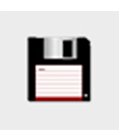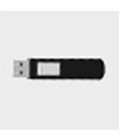
Our world has changed dramatically in the last 10 years. What it might look like in 20 years is hard to tell. And yet, it is necessary in many technical areas to choose solutions today, hoping that those solutions will be supported for a long time. Especially in the industrial sector new developments are associated with high levels of investment, which can only be profitable after a long period of time. By connecting technologies from the extremely fast-paced IT sector with the industrial systems and systems for automobiles and building management, designed for long-term use, new areas of tension come into existence. We will give a short overview of the history and future of storage media, file formats and regarding the availability of displays.
Storage media
In computing, storage media are reading and writing devices meant to save digital information. Below you find a short history of how this technology has evolved in the last few decades and what future trends can be expected.
Floppy Disk
 The Floppy Disk was the first widely extended storage device for personal computers. It was released in 1996 by Shugart Associates with a capacity of 360 kb, reaching up to 1,44 MB in later versions. Floppy disks, diskettes and superfloppies (modern versions of the first one) took over the market until the early 90s, with billions of units sold, until they were displaced with newer technologies.
The Floppy Disk was the first widely extended storage device for personal computers. It was released in 1996 by Shugart Associates with a capacity of 360 kb, reaching up to 1,44 MB in later versions. Floppy disks, diskettes and superfloppies (modern versions of the first one) took over the market until the early 90s, with billions of units sold, until they were displaced with newer technologies.
CD-ROM
 First versions of the CD-ROM have been offered by Philips and Sony in 1994 and had a capacity of 600 MB. This made them quickly popular and they started to substitute the aforementioned floppy disks, even though they were not re-writable. Their market share during the 90s was significantly large, but they have been progressively substituted by USB flash memories, SD cards and external hard disks.
First versions of the CD-ROM have been offered by Philips and Sony in 1994 and had a capacity of 600 MB. This made them quickly popular and they started to substitute the aforementioned floppy disks, even though they were not re-writable. Their market share during the 90s was significantly large, but they have been progressively substituted by USB flash memories, SD cards and external hard disks.
External hard disks
 External hard disks first showed up in the 80s. However, they were not commonly used because of their size (some of the first models were as big as an oven) or low storage capacity. In the last few years they have become more and more popular due to the large storage capacity that they now possess, measured in terabytes already, and due to their manageable size. They offer a good price-performance ratio with regards to their storage capacity.
External hard disks first showed up in the 80s. However, they were not commonly used because of their size (some of the first models were as big as an oven) or low storage capacity. In the last few years they have become more and more popular due to the large storage capacity that they now possess, measured in terabytes already, and due to their manageable size. They offer a good price-performance ratio with regards to their storage capacity.
USB flash drive
 Since 2000 almost everybody carries a USB stick in their pockets. First models of this device, commercialized by IBM and Trek Technology, stored 215 MB of information. Nowadays we can easily find 2 TB capacity USB sticks in any computer shop. Its big advantage when compared to previous storage systems is the large amount of data that can be stored in a few grams and the resistance against mechanical impacts.
Since 2000 almost everybody carries a USB stick in their pockets. First models of this device, commercialized by IBM and Trek Technology, stored 215 MB of information. Nowadays we can easily find 2 TB capacity USB sticks in any computer shop. Its big advantage when compared to previous storage systems is the large amount of data that can be stored in a few grams and the resistance against mechanical impacts.
CF cards
 CompactFlash cards (CF) were the predecessors of SD cards. They have been predominantly used in movable electronic devices. CF cards have been almost completely substituted by SD cards.
CompactFlash cards (CF) were the predecessors of SD cards. They have been predominantly used in movable electronic devices. CF cards have been almost completely substituted by SD cards.
SD cards
 Secure digital cards, or SD cards, appeared on the market in 1999. By 2005 they became the standard in the market to store and transfer information to portable devices, such as cameras, mobile phones or laptops, mainly due to their compact size. Their capacity is growing continually. The biggest SD cards are now offered with a capacity of 256 GB. Its later versions, the mini- and micro-SD, have become a standard as a storage medium in smartphones as well. With the help of adapters these cards can be used in larger card readers, too.
Secure digital cards, or SD cards, appeared on the market in 1999. By 2005 they became the standard in the market to store and transfer information to portable devices, such as cameras, mobile phones or laptops, mainly due to their compact size. Their capacity is growing continually. The biggest SD cards are now offered with a capacity of 256 GB. Its later versions, the mini- and micro-SD, have become a standard as a storage medium in smartphones as well. With the help of adapters these cards can be used in larger card readers, too.
File formats
The file format describes how the information in a file is stored and deposited on the storage medium. Several text formats or binary formats are used. The formats can be further distinguished into proprietary formats or open formats. Plain text formats are the easiest to manage, as they can be opened with almost any text editor. However, this makes them unsafe, as everybody has the tools to open them, and they take more space than their alternative. Binary formats are especially suitable to store programs, audio, video and images.
The difference between private and open format is that the first one is owned by a property holder who may demand royalties, while open format guarantees royalty free rights.
File formats are not static but are continually developed further. If this development is not open we might not be able to open the files in the future, or we might have to use special programs to do so. Some file formats might as well save more than we expect at first. Everybody knows the .Doc-format used to save text formats in MS Word. But these files can incorporate more than just the text. They can also transmit so-called macro viruses, which makes this file format less than ideal to exchange data.
Another important point regarding file formats is long-term availability. Open file formats have a clear advantage here, since there will always be tools offered that can read this formats. So besides storage media that are available for a long time, long-term available file formats are needed. For documents, for example, the use of PDF and PDF/A is very much recommended, since these formats are continually in further development (.pdf - 2.0 is expected for 2015). Other future-viable formats are, for example, .png for images; .flac and .mp3 for music and .vp8 for videos.
You can find a list of common file formats under fileinfo.com.
The Cloud
Nowadays, we have all heard about the cloud. We know that there are some programs and apps such as Google docs, running on the cloud. Some use Dropbox or Google Drive as storage services in the cloud and we have all heard something like “the cloud is the future”. But what is the cloud? How does it work? And how will it change our way of working with our computers and displays? Why is it the future?
The cloud is a group of servers that allows their users to exchange or save data, run their applications on their servers, or use the service of programs via an existing internet connection. Thus, a device-independent exchange of data and services is possible. This makes cloud-applications so interesting.
Many cloud services are offered for free. After registration with the provider it is possible to use the service with various devices worldwide. But it should be a concern for the user where the storage of data takes place and whether they will be analyzed by the provider or even passed on to third parties. If one wants to be absolutely secure only European cloud services should be used, as these services are subject to European data protection laws. Alternatively, it is possible to use encryption software, such as Boxcryptor.
All the advantages and the possibilities that are enabled by the cloud make it a technology for the future, that will see continuing strong growth.
Displays
Most displays are now being manufactured in Asia. Often a special construction type for a specific consumer product will be developed and then manufactured in a quantity in which this product is offered on the market. With the disappearance of the product the display production ceases, too. Therefore a hard to grasp supply of displays in different construction types occurs, without them being available for a longer period of time. If such a display is replaced by a successor product small changes in measurements, in the electric connection, in the control interface, the brightness and contrast and many parameters more, might occur. This is makes it very hard to guarantee long deliverability for displays.
Especially in the industrial sector and in building automation there are investment goods that are construed for long-term use. Suppliers of displays for these markets have to check the availability of the displays when choosing a display and include special constructive measures to guarantee an exchange.
